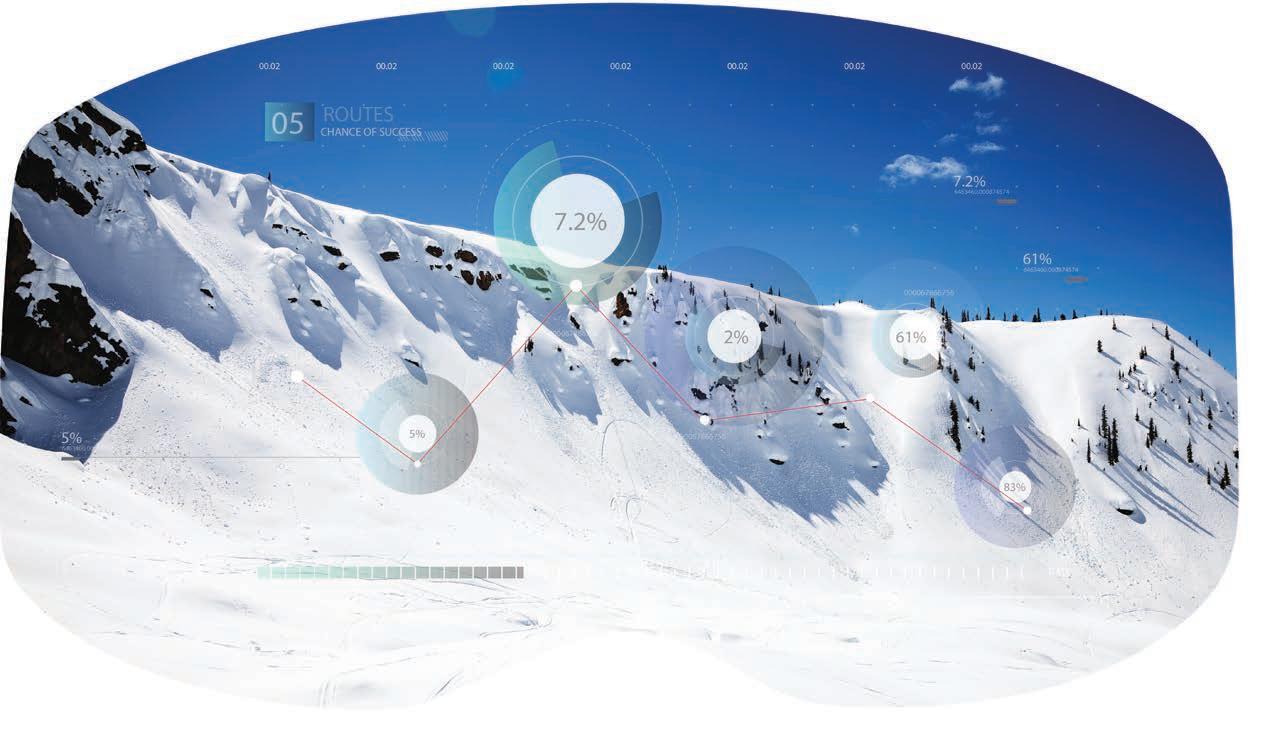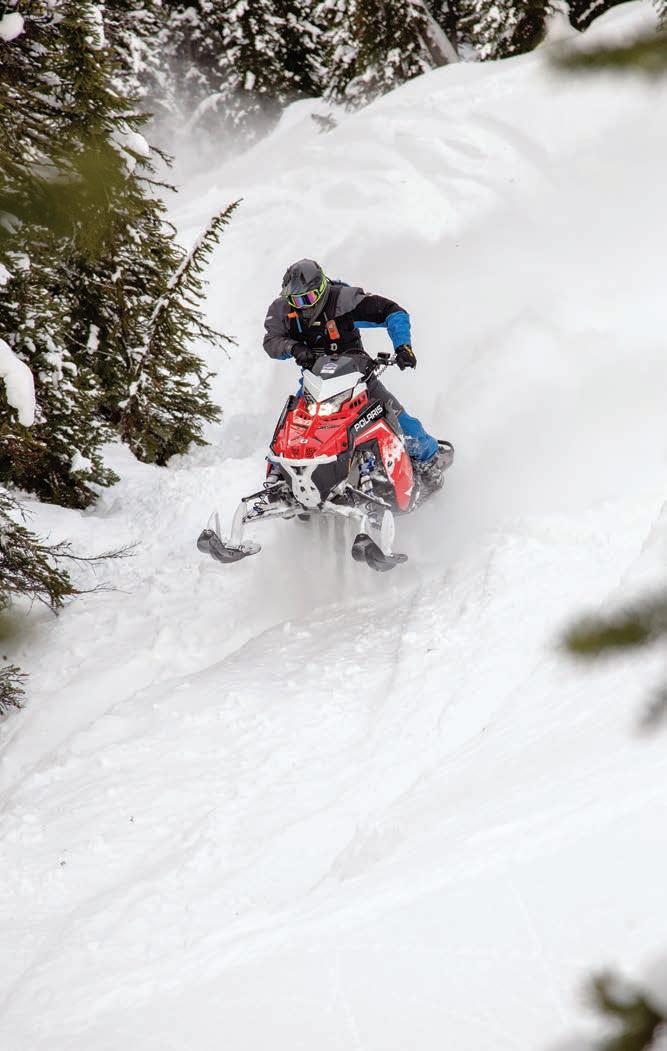
4 minute read
THE FUTURE OF RIDING
A PREDICTIVE LOOK AT A TYPICAL RIDE IN THE NOT-TOO-DISTANT FUTURE
BY MARTY ANDERSON
Advertisement
Self-driving cars are here already and one has to imagine that if the technology can safely navigate an automobile amongst other traffic, multiple lanes, stoplights and sudden obstacles like bicycles and pedestrians, then surely it could keep a sled between two snowbanks on a groomed trail.
But at what point does the use of technology begin to diminish rather than enhance the enjoyment of our sport?
Here’s a look at what the next ten years of technological development in our sport might bring…would you want to ride this way?
A Ride In The Future
At the trailhead, a fresh layer of snow from last night sparkles in the sunshine rising above the horizon.
traffic volume. One human supervisor can remotely monitor the progress of several groomers at once, all from the warmth of their own home. The groomers stay in constant contact with all riders on the trail, updating their location in real-time to keep everyone safe.
You head up the precisely groomed trail, taking a glance at the heads-up display (HUD) inside of your Intelli-visor:
Defrost: on, in auto-regulation mode
Slider Condition: a little warm but no problem, the scratchers will selfdeploy when needed
Belt Temperature: climate controlled and within range
Fuel Mixture: optimized for mileage
Machine monitoring and diagnostics have come a long way in the past few years and you have nothing to worry about—all systems are good.
Just as you settle in for the half hour ride to the alpine, a familiar warning chime bings inside your helmet. A light in the periphery of your visor confirms that you are approaching a bARGe—an Autonomous Remoteassist Groomer, like an oversized Roomba vacuum on tracks. These driverless trail groomers run all day, keeping the trail perfect regardless of
Your mind wanders to a recent report of the major snowmobile manufacturers testing self-driving models on select trails. The system is a simplified version of the ones used in the automotive world and the beta test units are performing well. As you maneuver around the bARGe, you wonder if you could ever fully trust a computer to do the steering for you. You had enough trouble accepting electronic steering at first.
A few quick miles later and you break into the open bowl and look up at the mountain peaks for the first time today. A quick loop of the field gives your sled computer some data to analyze, sensors working to measure the thickness, density and cohesiveness of the snowpack at this elevation.
The program algorithm cross references today’s forecast, recent weather events and the current snow conditions data it has gathered through the track and skis. This info is analyzed together with a data packet from the Avalanche Canada forecast center that is updated in real-time. Within seconds, your sled knows more about the snow conditions and avalanche hazard potential than you would learn from digging ten test pits.
You stop and scroll through options to bring up “Routes” on your oversized dash display. A 3-dimensional projection of the surrounding mountains appears, along with safe travel routes and terrain warnings. You select a path straight up through the trees with a sidehill out the top. A red line flashes; that line is not recommended. Based on previous attempts and historical data, the chance of success is rated at 7%. But that would put you in the Top 5 on the 30-day leaderboard for this zone. Let’s go for it.
As you climb, your in-visor HUD flashes safe turnout spots, but you ignore them all as you head for the top. As you start the sidehill above the trees with too little speed, the line choice warning gets more urgent; your sled already knows you won’t make it, even if you don’t.

You lose the line and bail, sending your sled down through the trees below. As you sit and stare at the “Error - Rider Abandonment” message flashing inside your helmet, you listen to the cringe-inducing sound of a sled crashing through brush and snapping off trees and branches as it plummets down the hill. With a sigh you realize that some things never change, and you begin the climb down after it.
The crash was sufficient to trigger the GPS-based emergency warning alert, notifying emergency services and your pre-set contacts via satellite of an incident at your location. Reaching the sled, you quickly cancel the alert and send out an “I’m Okay” message to your spouse and Search & Rescue, so they know to stand down. A couple of nearby sledders (who received a notification of a nearby incident) ride over to check if everything is okay.
You run the self-diagnostic on your sled, and after a moment the report reveals that an A-arm has been critically damaged in the heroic run down the side of the mountain. Not an overly expensive repair, but your sled is unrideable at this point. You contemplate how you will make it home. One of the riders in the group offers the solution: he recently signed up to a new service called “Parts Alert”. He logs into his phone and with a few clicks
(make, model, year) the order is placed and a drone is dispatched from the local dealer with a replacement A-arm and the wrenches needed to change it. ETA is about 20 minutes.
Settling in to wait, you check the digital temperature display on your exhaust cooker and see that your food is still only at 25˚C. Lukewarm at best. At least your “Onboard Barista” OEM accessory espresso machine is still functional.
Your newfound friends hang around and chat while you wait, making jokes about the incoming drone. There is talk of a new restaurant drone service coming soon that can deliver burgers and beers, but you’re not sure if it would deliver food this far up the mountain.
Your helmet warning beeps again and you look to see the autonomous groomer turn around at the treeline and head back down the trail again. At least the ride home will be smooth.





